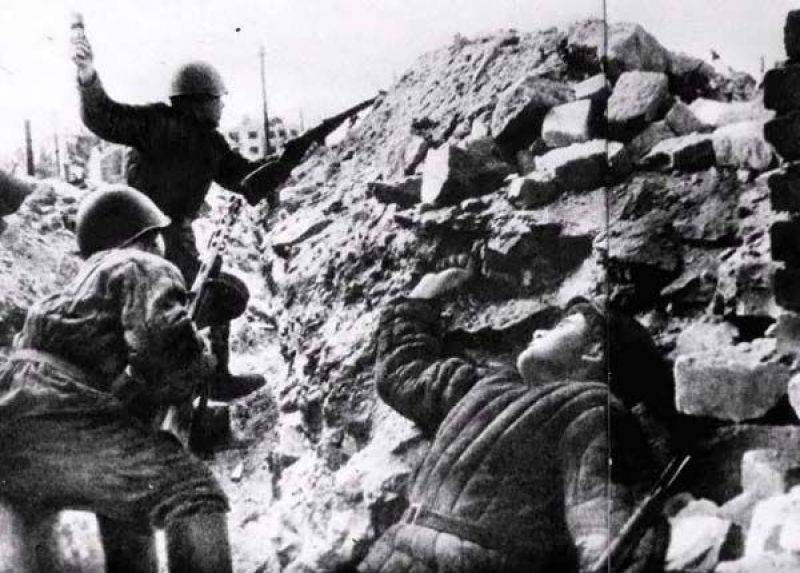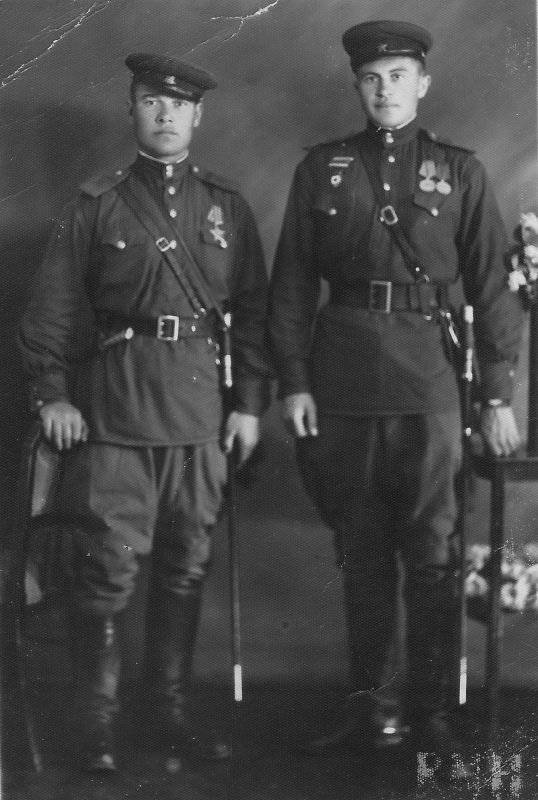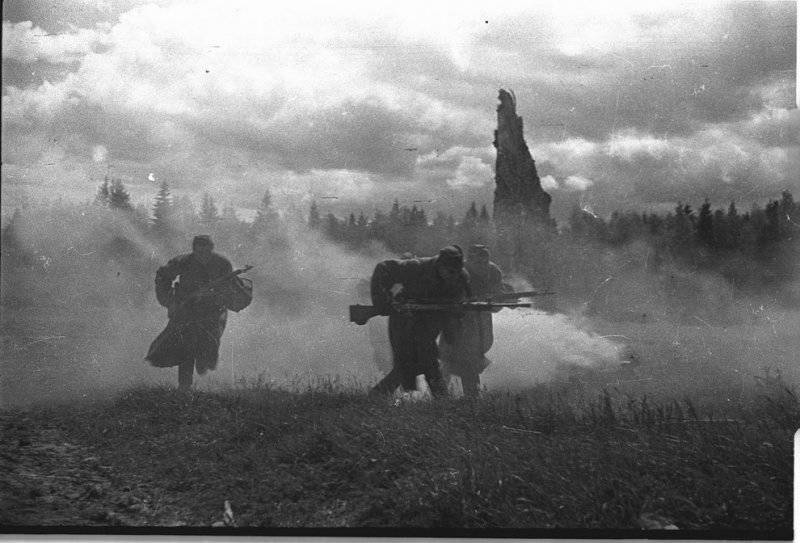Penalty battles attack
Penal units of battalions and companies appeared in the Red Army only in July 1942, after the release of the famous order of the USSR People's Commissar for Defense N 227 from 28 in July 1942, the famous order “Not one step back.” It was a time when mortal danger loomed over our country, the German troops rushed to Stalingrad.
According to order No. 227 in the Red Army for persons of middle and senior commanding and political personnel guilty of breach of discipline on cowardice or instability, from the front were created from 1 to 3 penal battalions (800 people each). For ordinary soldiers and junior commanders guilty of similar violations, within the army there were created from 5 to 10 punitive companies (from 150 to 200 people in each). The penal units were supposed to be sent to the most difficult sectors of the front in order to give them the opportunity to atone for their crimes with the blood before their homeland.

As we can see, the main difference between penal battalions is that command personnel (senior and middle commanders, later officers) served in them, and ordinary fighters and junior commanders (later privates, sergeants and sergeants) in penal companies.
The term of punishment was calculated from a month to three, the wound received even on the first day of stay in the penal division automatically returned the fighter to the unit for the same position, in the same military rank, so that service in the penalty box when fighting went on was considered not even a day, and for hours, so she was dangerous.
Penal battalions were under the authority of the military councils of the fronts, penal companies - the military councils of the armies. For the direct conduct of military operations, the penal units were attached to rifle divisions, brigades, and regiments.
The servicemen were sent to penal battalions by order of the division (corps, army, front - in respect of parts of the relevant subordination), and in penal companies - by order of the regiment (separate part) for the period from 1 to 3 months. For the same period, they could have sent to the penalty part individuals convicted by a military tribunal using a deferment of the sentence until the end of the war (on the basis of Article 28-2 of the Criminal Code of the RSFSR, 1926 of the year). All sent to the penal units were demoted to the rank and file, their awards for the time spent in the penalty part were to be deposited in the personnel department of the front (army). Commanders and commissars of battalions and regiments could be sent to the penal battalion only by the verdict of the military tribunal.
Later, on September 28, 1942, Deputy People’s Commissar of Defense of the USSR, Army Commissioner 1 of rank X. Shchadenko, issued Order No. 298, which declared provisions for penal battalions and penal companies, as well as the staff of the penal battalion, penal company and defensive squad.
According to these documents, the servicemen of the penal units were divided into permanent and variable composition. The permanent staff was recruited "from among the strong-willed and the most distinguished in the battles of commanders and political workers." For special conditions of military service, they received appropriate benefits. The battalion command, staff and command officers, company commanders, platoons, political leaders of companies and platoons, sergeants, clerks, and medical order officers of the companies referred to the permanent composition of the penal battalion. The company commander and military commissar, company clerk, commanders, political instructors, sergeants and medical instructors of platoons belonged to the permanent company in the penal company. That is, the commanding staff of the subunit consisted not of penalties, but of specially selected commanders and political workers, since not every commander was able to control such a specific subdivision as penal battalions and companies, where it was necessary not only to command correctly, but also the decisive moment of the battle to raise and lead the attack of penalty box.
As for the variable composition, that is, the penalty box, regardless of the previous military rank, they served as privates, and could also be appointed to junior command positions. So the former colonels and captains with rifles and machine guns in their hands clearly carried out the orders of lieutenants, commanders of penal platoons and companies.
Not only the guilty military personnel got into the penal units. Persons convicted by judicial bodies were also sent there, however, courts and military tribunals were prohibited from sending convicts convicted of counterrevolutionary crimes, banditry, robbery, robberies, recidivist thieves, persons who had previously been convicted of the above crimes, as well as repeatedly deserting from the Red Army. In other categories of cases, when deciding whether to postpone the execution of the sentence with the direction of the convicted person to the army, the courts and military tribunals, when deciding, took into account the personality of the convicted person, the nature of the crime and other circumstances of the case. Not everyone has been given such an opportunity as to atone for his guilt with blood at the front.
A year later, already in 1943, another kind of fighter units appeared in the Red Army, these are the so-called separate assault rifle battalions, for which we know much less of them for some reason. So 1 August 1943 of the year issued the order of the People's Commissar of Defense No.Org / 2 / 1348 "On the formation of individual assault rifle battalions" which ordered: "In order to provide an opportunity for the command and control structure, which was located for a long time in the territory occupied by the enemy, and did not participate in partisan detachments, with weapons in the hands to prove their loyalty to the Motherland "These penal divisions were formed only from the commanders of command and control personnel contained in special NKVD camps. In the beginning, 4 of such assault battalions of 927 personnel each were formed. The assault battalions were intended for use on the most active sections of the front. The duration of the stay of the personnel in separate assault rifle battalions was established for two months of participation in the battles, or until the award of an order for display l in battle or until the first wound, after which, if there are good attestations, the personnel can be assigned to the field troops to the appropriate positions of command and commanding personnel. ”Subsequently, the formation of assault battalions was continued. , although there were significant features, So, unlike the penalty box, those who went to the assault battalions were not convicted and were denied officer ranks. Strange as it may sound, but the families of the personnel assigned to the battalions from the special camps of the NKVD were given all the rights and benefits defined by law for the families of the commanding officers of the Red Army. There was still one difference between assault battalions and ordinary penal battalions, so if in penal battalions (as well as in penal companies) the permanent composition held all posts, starting with platoon commanders, in assault battalions only members of the battalion commander, his deputy for political affairs , chief of staff and company commanders. The remaining posts of the middle command were occupied by the fighters themselves from the personnel of the assault battalion. And in the assault battalions, the appointment of commanders, both junior and medium, was made after a careful selection of commanders from the special contingent.
The term of stay in the assault battalion was two months (up to three months in the penal battalion), after which the personnel were reinstated. In practice, this often happened even earlier.

Photos from the family archive of Nikolai Ivanovich Lobakhin. Nikolai Ivanovich at the front from the first days of the war, 2 times was in the penal battalion, had several wounds. After the war, as part of the troops of the NKVD eliminated bandits in the Baltic States and Ukraine.
According to the memoirs of the front-line soldiers, those who went through the punitive battalions, the armament of these units was no different from the armament of ordinary rifle subunits. So, for example, the battalion consisted of three rifle companies, in which for each branch of rifle platoons there was a light machine gun, the company also included a company (50 mm) mortar platoon. There were also a company of machine gunners in the battalion, armed with RPM machine guns, gradually replaced by more modern PCA, and a machine-gun company, armed with which were not only the famous Maxim machine guns, but also more modern, light-weight machine gun Goryunov systems. The battalion of the PTR was also part of the battalion, which was also armed with the multiply-charged “Simonovskiy” rifles, was composed of the battalion and mortar company - 82 mm mortars. The supply of ammunition was also uninterrupted, and penal agents often threw gas masks before the attack in order to fill the empty bag to the limit with grenades or cartridges. The same should be said about the organization of food, all penalty box consisted on the boiler allowance, like any other military organization.
In total, in the Red Army from 1943 to May 1945 of the year, in some periods there were up to 65 penal battalions and up to 1037 penal companies, but these figures cannot be considered accurate, as the number of penal battalions and companies constantly changed, they were not permanent divisions, some were disbanded, others were reformed, etc.
Penalty units existed in the Red Army from September 1942 to May 1945. In all, 427 910 people were sent to the penal units for the entire war. On the other hand, 34 476,7 thousand people passed through the Soviet Armed Forces during the war. It turns out that the share of servicemen who have been in penal companies and battalions is only 1,24% of the entire staff of the Red Army.
During the fighting, fines units typically performed the following tasks:
- conducting reconnaissance in order to identify the firing points, lines and demarcation lines of the enemy's defense;
- the breakthrough of the enemy's defense lines to seize and hold the set boundaries, strategic heights and bridgeheads;
- storming the enemy’s defense lines in order to carry out distracting maneuvers and create favorable conditions for the offensive of the Red Army in other areas;
- conducting "disturbing" positional battles, which hold down enemy forces in a certain direction;
- performance of combat missions as part of the rearguard to cover the units of the Red Army as they retreat to previously prepared positions.
Since the penalties were entrusted with the most difficult combat missions, therefore the losses among them, both in the permanent and in the variable composition of the penal divisions, were quite high. Thus, in 1944, the average monthly loss of a variable composition killed, dead, wounded and sick reached 10 506 people, permanent - 3685 people. This is 3 — 6 times more than the level of casualties for ordinary troops in the same offensive operations.
Penalties who were wounded in battle were considered to have served their sentences, were restored to the rank and were granted all rights and after recovery for further service in ordinary units, and people with disabilities received pensions from the salary of the last post before being transferred to the penal battalion.
Families of the fallen victims of penalties were granted a pension on a general basis with all families of commanders from the salary of the last position before being sent to the penal battalion. After the end of World War II, all penal units in the Red Army were disbanded.
Here's a story penalties The people who went through these battalions and companies bore all the burdens, hardships and terrors of the war, while showing courage and heroism. Eternal memory for it!

Information